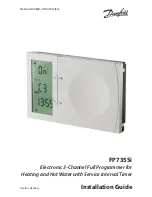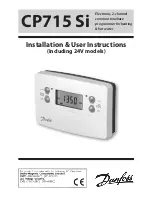
81
•
DHW sensor:
A
rapid reaction
to changes in the water volume is extremely important
when using the controller in systems that generate domestic hot water by means of an
external heat exchanger and variable speed pump (freshwater module). Therefore fit the
DHW sensor directly on the heat exchanger outlet. This
ultra-quick
sensor (special
accessory, type
MSP
...) should protrude into the output with the aid of a tee sealed in
with an O-ring. The heat exchanger should be installed upright with the DHW outlet at the
top
.
•
Radiation sensor:
The parallel collector orientation is important in order to obtain a mea
-
surement that corresponds to the collector position. Consequently it should be secured
to the sheet steel covering or adjacent to the collector on an extension of the mounting
rail. To this end, the sensor casing has a blind hole that can be opened at any time. The
sensor is also available as a wireless version.
•
Room sensor:
This sensor is intended for installation in the living space (reference
room). Do not install the room sensor near a heat source or window. By simply replug
-
ging a jumper inside the sensor, each room sensor can also be used exclusively as a
remote adjuster (no room temperature influence). It is only suitable for operation in dry
rooms. The sensor is also available as a wireless version.
•
Outdoors temperature sensor:
This sensor is installed on the coldest wall (usually fac
-
ing north) some two meters above the ground.Avoid temperature influences from nearby
air shafts, open windows, cable ways, etc. It must not be subjected to direct insolation.
Sensor lines
All of the sensor lines with a cross-section of 0.5mm2 can be extended up to 50m. With this
length of line and a Pt1000 temperature sensor, the measurement error is approx. +1K. Lon
-
ger lines or a lower measurement error require an appropriately larger cross-section. In order
to prevent measurement fluctuations, the sensor cables must not be subject to negative ex
-
ternal influences to ensure fault-free signal transmission. When using non-screened cables,
sensor cables and 230V network cables must be laid in separate cable channels and at a
minimum distance of 5 cm. If screened cables are used, the screen must be connected to
the sensor earth.
Summary of Contents for UVR65
Page 2: ......
















































